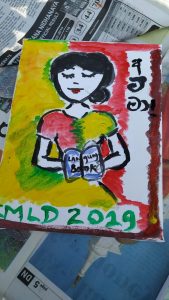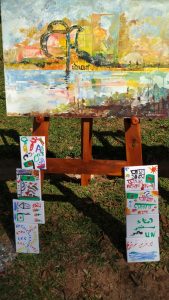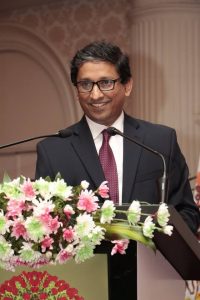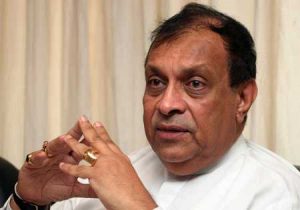Colombo, February 21 (newsin.asia): The lush green Vihara Mahadevi Park in the Sri Lankan capital was a beehive of activity on Thursday. Over 250 boys and girls, all school children in their spotless white uniforms, were squatting on the sprawling lawns, crouched over thick white sheets of paper with a tray of paints in one hand and a brush in the other, giving impromptu pictorial expressions to their love for the mother tongue.
The occasion was an observance of the International Mother Language Day organized by the Bangladesh High Commission in Sri Lanka with the assistance of the Sri Lankan Ministry of Official Languages.
The idea behind the observance was to draw attention to the importance of preserving and fostering the mother tongue in the face of challenges to indigenous languages arising from politically dominant forces, globalization and migration.
Watching the kids’ creative exercise, which showed the amazing variety of ways in which the mother tongue is conceived by children, were top personalities from Sri Lanka and abroad.
Among those present were parliament Speaker Karu Jayasuriya, Governor of the Western Province Asad Sally, Chairman of the Elections Commission Mahinda Deshapriya, Power Minister Ravi Karunanayake, Official Languages Minister Mano Ganeshan and no less than 17 foreign envoys.
While the kids and the guests were being entertained, a group of students from a Tamil medium school in Colombo went on stage at their own initiative and sang a song in Sinhalese to everyone’s surprise and delight. The kids had spontaneously built a bridge across the linguistic divide in Sri Lanka.
This was the third in the series of International Mother Language Day celebrations organized by the Bangladesh High Commissioner, Riaz Hamidullah.
“Each edition was woven around a particular theme. The first one was on Language for Peace and Prosperity; the second was on Language and Unity; and the third was on Celebrating Languages,” the envoy said.
Stressing that recognizing language rights is key to ethnic reconciliation, Hamidullah said that his next plan is to hold Mother Language Day celebrations in Jaffna and Vavuniya in North Sri Lanka with the cooperation of the government of Sri Lanka and the envoys of various countries.

Importance of Preserving Languages
Speaking on the occasion, Sri Lankan parliament Speaker Karu Jayasuriya said that the mother language is a manifestation of the identity of organized human societies across the planet. Nevertheless, due to the globalization processes, many of these languages are increasingly under threat, or often disappearing altogether, he lamented.
“When languages decline, so does the world’s rich tapestry of cultural diversity. Traditional knowledge, unique modes of thinking and expression, which are valuable resources for human existence, are also lost,” Jayasuriya pointed out.
At least 43% of the estimated 6000 languages spoken in the world are reportedly endangered. Only a few hundred languages have genuinely been given a place in education systems and the public domain, and less than a hundred are used in the digital world, he said.
“Without doubt, languages are the most powerful instruments of preserving and developing our tangible and intangible heritage. All moves to promote the dissemination of mother tongues will serve not only to encourage linguistic diversity and multilingual education but also to develop fuller awareness of linguistic and cultural traditions throughout the world and to inspire solidarity based on understanding, connectivity, tolerance and dialogue,” he added.

But the forces working against the multiplicity of languages are strong and are becoming more and more influential.
“Rapid advancement in communication technology often for convenience and economic reasons to facilitate fast and effective communication across nations can adversely impact mother languages. As a result, mother languages can be marginalized and their dignity can get progressively diminished.”
“In this context, all initiatives to celebrate the value of mother languages are laudable efforts. They provide platforms to promote communal harmony, multiculturalism and reconciliation among communities and societies across the world. Moreover, celebrating and promoting each mother language is an essential tool for upholding the dignity of each human society,” Jayasuriya said.
“In this context, all initiative to celebrate the value of Mother Languages are laudable efforts. They provide platforms to promote communal harmony, multiculturalism and reconciliation among communities and societies across the world. Moreover, celebrating and promoting each Mother Language is an essential tool for upholding the dignity of each human society, the Speaker added.

Origin of International Mother Language Day
The movement for the protection of the mother tongue and its subsequent recognition as the International Mother Language Day owe their origin to the language crisis in East Pakistan soon after Pakistan got independence in 1947 and the commitment of Bangladesh to promote the cause of the mother tongue.
The move by the Urdu speakers of West Pakistan to impose their language as the sole official language of Pakistan ignoring the claim of Bengali spoken by the people of East Pakistan, triggered a struggle in 1952 which ultimately led to the creation of a separate country called Bangladesh in 1971.
Since the Bengali language movement sought to have the linguistic and cultural rights of an entire population recognized and respected, an appeal was made to UNESCO by the Bangladesh government to declare a day as International Mother Language Day to save threatened languages and their attendant cultures.
In 1999, at the initiative of Bangladesh, UNESCO declared February 21 as the International Mother Language Day to stress the need to preserve, foster and save languages, hundreds of which had been dying for economic, social and political reasons.
On November 17, 1999, UNESCO declared February 21st as International Mother Language Day. It was ratified by the UN General Assembly a decade later “to promote the preservation and protection of all languages used by peoples of the world”.

Dying Languages
According to the UNESCO Atlas of the World’s Languages in Danger, between 1950 and 2010, 230 languages went extinct. A third of the world’s languages have fewer than 1,000 speakers left. Every two weeks a language dies with its last speaker. Fifty to ninety percent of the existing languages are predicted to disappear by the next century.
For much of the 20th century, governments across the world had imposed languages on indigenous people, often through coercion. Some 100 aboriginal languages in Australia had disappeared since European settlers arrived. Today, globally, 40% of the population does not have access to an education in a language they speak or understand.
Why Languages Go Out of Use
Languages disappear for various reasons. Among them are: political suppression; demographic inequalities; national need for uniformity; administrative convenience; globalization, migration across linguistic regions for economic reasons; emergence of international languages due to globalization; the need for linguistic mergers to meet a common threat.
In India, the move by the Central government to make Hindi the sole official language of the country led to a violent movement in the State of Tamil Nadu in the 1960s. The Tamils feared that they would be overwhelmed by the country’s Hindi-speaking majority which provided the country’s political elite.
The adoption of English as an associated official language in India was dictated by the need to have a common language to administer multi-lingual India. But with the elite adopting English as their first language, the use and prestige of Indian languages suffered. Globalization, with English emerging as the preferred world language, only further strengthened the dominance of English speakers in India.
International migration brought about by economic globalization enhanced the value of languages like English and downgraded other Indian languages. Urbanization within countries led to internal migration, which in turn led to the adoption of a new language or languages and the disappearance or non-use of other languages.
The language of the political elite tends to get adopted by others for social and economic survival and mobility. For example, the Eurasian Dutch Burghers of Ceylon, whose mother language was Dutch under Dutch rule, adopted English when the British took over the island because they wanted to continue to be associated with the White ruling class.
Linguistic Mergers
In democracies (where numbers count), small linguistic groups merge to form bigger units to get greater political clout. Many individual languages in North India were downgraded and fell into disuse when Hindi was adopted as the common language of the “Hindi belt”. The Hindi speaking “majority” in today’s India, is actually a coalition of several linguistic groups like the Mythili, Bhojpuri, and Awadhi groups. today, collectively, the “Hindi speakers” are the most powerful in India.
In Karnataka State in South India, languages like Tulu and Coorgi were set aside, and Kannada was adopted as the language of the State to give Karnataka linguistic uniformity and a single identity. But this has created a problem in Belgaum in North Karnataka, where Marathi speakers are not willing to get submerged in the Kannada identity. The language problem here has created a Marathi speakers’ movement to seek union with Marathi-speaking Maharashtra.
Sri Lankan Divide
In Sri Lanka, the 70-year ethnic issue had its beginnings in language use. The SWRD Bandaranaike government’s declaration in 1956 to make Sinhala the only official language in Sri Lanka triggered protests in the Tamil-majority areas of the Northern and Eastern parts of the island. The movement for language rights eventually led to an armed struggle for a separate Tamil Eelam.
Facilities for the use of Tamil, which is the mother tongue of the Tamils and Muslims, are still poor though Tamil speakers account for about 20 to 25% of the population. Offices do not have enough translators. The recruitment of Tamils to the civil service is still hampered by the linguistic divide created in schools where students are forced to learn through their mother tongue with little scope for interaction and inter-communication with children learning through another language. The seeds of language animosity in Sri Lanka are planted at a young age.
The Sri Lankan case shows that while education through the mother tongue is the best, facilities should be created for interaction between linguistic groups so that they may appreciate and learn each other’s language.



























































